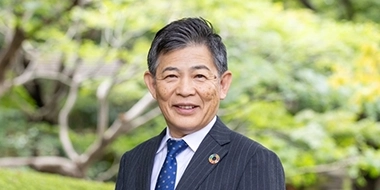
Fostering Workplace Diversity
Basic Approach and Policy
DE&I (Diversity, Equity & Inclusion)
In 2021, Nabtesco made a statement about its approach to ensuring diversity in the workplace.
Approach to Ensuring Diversity in the Workforce
As a precondition to enhance the sustainability of society and companies alike, it is necessary to innovate continuously. In order to innovate in this age of VUCA, which is characterized by the intensification of global competition and progress of IT, it is necessary to accept and fuse together a range of values.
We have since been proactively utilizing diverse human resources by promoting women in the workplace, developing digital transformation and global human resources, utilizing the experience of senior human resources, and implementing other measures regardless of attributes such as age, gender, nationality and desired form of employment. Through these efforts we are striving to provide them with jobs that they can perform with high motivation, demonstrating their respective abilities to the fullest. To this end, we are committed to improving our workplace environment and providing our managers with the education they need.
In order to achieve “Innovation in Action,” as upheld in our long-term vision for 2030, we will implement human resource-related measures, thereby helping diverse employees enjoy and be excited about taking on challenges as part of their work.
Measures
Active Employment of Non-Japanese Nationals
The Group operates in 20 countries and regions across the world and have 74 bases globally, where a total of about 8,200 employees are working. In the global enterprise, about 3,200 employees (or about 39% of all Nabtesco Group employees) are non-Japanese, who have diverse backgrounds. We are fostering the localization of our overseas Group companies and working to secure the talent necessary for our global operations. We will continue our efforts to build a global management system while respecting differences in employees’ experiences, cultures and values.
- *The calculation scope covers Nabtesco consolidated. The figures are based on the human resources data.
In particular, non-Japanese employees have different ways of looking at things and active attitudes toward working, and as such, it is thought that they will help reform the attitudes of other personnel in day-to-day life at work. Under the assumption of communication occurring in Japanese, we are actively recruiting not only excellent human resources with advanced expertise or skills but also those who proactively think and can achieve their work while ensuring the involvement of the people around them.
For new graduates employed by Nabtesco as career-track employees in and after 2023, the company has set the target of increasing the proportion of non-Japanese nationals to 20%. For managerial positions, it has set the target of increasing the proportion of non-Japanese nationals to 2% by 2030. In order to attain these targets, we will proactively recruit non-Japanese nationals while supporting our existing non-Japanese employees in their career development.
Breakdown of Non-Japanese Employees
| 2023 | |
|---|---|
| China | 41 |
| Republic of Korea | 13 |
| Vietnam | 2 |
| Czech Republic | 1 |
| Brazil | 1 |
| Malaysia | 1 |
| Mongolia | 1 |
| Jordan | 1 |
| Total | 61 |
- *As of December 31, 2023
- *The calculation scope covers only Nabtesco Corporation. The figures are based on the human resources data.
- *Employees from Hong Kong are counted as Chinese citizens.
Total Number of New Graduates Employed by the Company as Career-Track Employees and Percentage of Non-Japanese Nationals in Managerial Positions
| 2018 | 2019 | 2020 | 2021 | 2022 | 2023 | |
|---|---|---|---|---|---|---|
| Total number of newly recruited main career track employees (persons) | 40 | 29 | 32 | 23 | 26 | 33 |
| Number of non-Japanese nationals (persons) | 4 | 3 | 0 | 1 | 5 | 5 |
| Percentage of non-Japanese nationals (%) | 10.0 | 10.3 | 0.0 | 4.3 | 20.8 | 15.2 |
| Number of employees in managerial positions (persons) | 349 | 356 | 362 | 367 | 321 | 337 |
| Number of non-Japanese managerial positions (persons) | 6 | 7 | 6 | 6 | 4 | 3 |
| Ratio of non-Japanese managerial positions (%) | 1.4 | 1.7 | 2.0 | 1.7 | 1.6 | 0.9 |
- *The calculation scope covers only Nabtesco Corporation. The figures are based on the human resources data.
- *Since newly-recruited non-Japanese nationals could not come to Japan in FY2020 due to the effects of COVID-19 and joined the Company in FY2021, they are included in the figures for FY2021.
Proactive Employment and Promotion of Women
Nabtesco are developing proactive recruitment activities by setting the target of increasing the proportion of women among new graduates hired as career-track employees to 30% in and after 2023. However, women account for a very small percentage of the total number of university students who major in mechanical engineering, electrical/electronic engineering, and information science, who are our primary recruitment targets.
To attract more female engineering students as a B-to-B machinery manufacturer, we thus need to increase our public profile and differentiate ourselves from our competitors. We also need to provide students with detailed information on work that is consistent with their desired careers at the company.
To meet this requirement, we will hold events targeting these female students, not limited to job seekers, as early as possible and provide them with more opportunities to interact with our employees. Through these measures we will help more of these students learn about Nabtesco throughout the year, while also working to increase the comfort levels at our workplaces and giving due consideration to regional characteristics for ongoing recruitment.
In FY2023, women accounted for 10.2% (16.7% on a consolidated basis) of all employees and 4.7% (7.5% on a consolidated basis) of employees engaging in jobs related to science, technology, engineering and mathematics (STEM). In terms of the promotion of women, the female managerial position rate in revenue-generating departments was 1.1% (2.5% on a consolidated basis). In addition, women accounted for 3.0% (7.3% on a consolidated basis) of all management positions, of which 1.1% (6.1% on a consolidated basis) were equivalent to General Managers (including Directors) and 3.7% (8.0% on a consolidated basis) were equivalent to Section Managers. The percentage of female executive officers is 2.6% on a consolidated basis.
Total Number of Newly Recruited Main Career Track Employees (New Graduates) and Percentage of Women
- *The calculation scope covers only Nabtesco Corporation. The figures are based on the human resources data.
Gender Pay Gap
The following table shows the gender pay gap for FY2023.
(Unit: %)
| Classification | the gender pay gap (Ratio of women’s salaries to men’s) |
|||||
|---|---|---|---|---|---|---|
| Annual income | Monthly salary | Bonus | ||||
| Average | Median | Average | Median | Average | Median | |
| All workers | 80.6 | 84.4 | 82.7 | 82.7 | 75.0 | 89.5 |
| Regular workers | 82.7 | 86.1 | 84.6 | 84.4 | 77.9 | 91.1 |
| Non-regular workers | 70.5 | 70.6 | 82.5 | 79.0 | 37.9 | 42.6 |
- *Targeted period: FY2023 (January 1 to December 31, 2023)
- *Regular workers: Managers and regular employees
- *Non-regular workers: Part-timers and fixed-term workers including reemployed retirees
- *Annual income: Include basic pay, overtime allowance and other allowances and bonuses but exclude retirement and commuting allowances.
Salaries of expatriates are calculated based on the amounts that they would receive if working in Japan, and the salaries of part-timers among non-regular employees are calculated based on the amounts that they would receive if working full time. - *Scope of calculation: Nabtesco on a non-consolidated basis and calculated based on its human resources data.
As a result of analyzing why such a gender pay gap exists, it has been revealed that the main cause of wage differences is the difference in basic remuneration, etc. according to position rank, because the percentage of upper-level position holders in the actual workforce differs between men and women.
In order to ensure that appropriate assignments are made regardless of gender and with a view towards the next stage at each workplace, in addition to strengthening the aforementioned pipeline, we hold “evaluation training” for supervisors to ensure that appropriate themes and targets are assigned and set based on position and rank.
Action Plan Based on the Act on the Promotion of Women’s Active Engagement in Professional Life
In consideration of the need to foster women’s empowerment and from the viewpoint of career development and work style reforms, we deem it crucial to provide workers with opportunities to fulfill their potential and truly thrive regardless of gender and to foster measures to support them in maintaining a good work-life balance.
Accordingly, based on the Act on the Promotion of Women’s Active Engagement in Professional Life (enforced on April 1, 2016), we formulated a new four-year action plan to start from April 2023 and will work to achieve the goals set therein.
Our Action Plan Set Based on the Act on the Promotion of Women’s Active Engagement in Professional Life
| Goal 1 | Increase the percentage of female managers to 4.1% of the total by the end of the period set for the action plan Measures: Training for female employees, diversity training for managers, and measures to foster career development |
|---|---|
| Goal 2 | Increase the percentage of male workers who take paternity leave following the birth of their child*1 to 100% of those who are eligible by the end of the period set for the action plan Increase the percentage of male workers who take childcare leave for three or more weeks*2 to 60% of those who are eligible. Measures: Measures to help mitigate workers’ concerns about taking leave and to create an environment that encourages them to take paternity leave |
- *1 The percentage is calculated by including all male workers taking leave under the childcare schemes.
- *2 The period of three or more weeks: Eligible employees are expected to take childcare leave for a total of four weeks, including the paternity leave period of five days to be taken following the birth of a child.
Employment of Mid-Career Workers
Nabtesco have also been proactively employing mid-career workers who have high levels expertise and broad experience gained by working for other companies, aiming to increase their number to 30% of newly hired employees. Among the rapid changes seen in the social environment following the pandemic, the job market is being revitalized. However, it is becoming increasingly difficult to employ IT engineers and electrical/electronic technicians, and in response, we will continue our career recruitment using a range of employment methods, including recruitment through referrals, comeback recruitment, and the hiring of freelance workers. We will also pursue the same 30% target for the proportion of mid-career hires in managerial positions.
Number of Mid-Career Hires and their Proportion in Managerial Positions
| 2019 | 2020 | 2021 | 2022 | 2023 | |
|---|---|---|---|---|---|
| Number of employed new graduates (persons) | 106 | 110 | 82 | 106 | 142 |
| Number of employed mid-careers (persons) | 36 | 38 | 29 | 50 | 61 |
| Ratio of employed mid-careers (%) | 34 | 35 | 35 | 47 | 43 |
| Number of employees in managerial positions (persons) | 356 | 362 | 367 | 314 | 337 |
| Number of employed mid-career managerial positions (persons) | 124 | 125 | 128 | 100 | 107 |
| Ratio of employed mid-career managerial positions (%) | 35 | 35 | 35 | 32 | 32 |
Promoting Employment of Senior Persons
Our continued employment system provides a consolidated environment for experienced employees to maximize their performance levels, such as special benefit for those with advanced expertise.
Due to the revision of the National Pension Act, the rate at which Nabtesco re-employs retired employees will further increase beyond the present level of over 70%.
Experienced employees are sharing their skills with their successors and at each production site team members are conducting activities to turn their tacit knowledge into explicit knowledge. These activities have become an intellectual asset to support our current technical capabilities.
Re-Employment Rate of Retirees
- *The calculation scope covers only Nabtesco Corporation. The figures are based on the human resources data.
Promoting Employment of Persons with Disabilities
The Group have made efforts to maintain the employment of people with disabilities. The employment rate of persons with disabilities is above the statutory rate, every year, and in FY2023, we achieved a 2.74% rate of employment. The statutory employment rate will be raised from 2.5% to 2.7% on July 1, 2026. In response, we will make further efforts to continue to achieve the statutory rate and promote the employment of people with disabilities.
In October 2016, Nabtesco Link Corporation, a Group company founded in July 2015, was approved by the Minister of Health, Labour and Welfare as a Specialized Subsidiary Company that is set forth in the Act on Promotion of the Employment of Persons with Disabilities.
Since then, Nabtesco Link has promoted the employment of persons with disabilities and made efforts to arrange the working environment to allow employees to work with a sense of purpose. In FY2017, Gifu Prefecture selected Nabtesco Link as one of the model employers for the employment of persons with disabilities in agriculture.
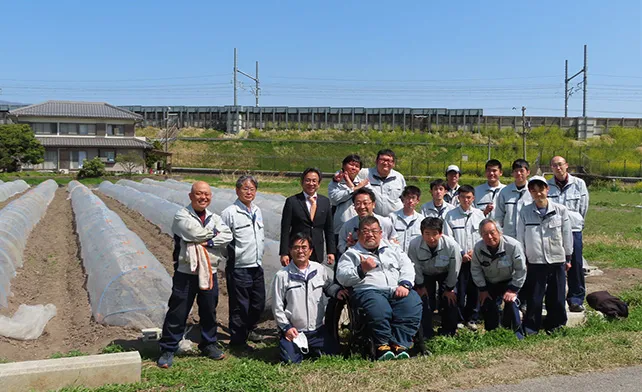
A group photo of Nabtesco Link Corporation
Employment Rate of Persons with Disabilities
- *The numbers in FY2016 and later are total sums and year-round numbers of Special Subsidiary Company-applied group companies.
Work-Life Balance
We expect that each employee maintains their mental and physical health, enhances their quality of work, plays their roll at work while feeling a sense of fulfillment and satisfaction, and leads a satisfactory private life at home and in the community. We believe such a lifestyle will develop new values and concepts. Therefore, we have a wide spectrum of schemes in place to promote a healthy work-life balance. In 2016, we set up a special committee of labor and management that aimed to discuss and implement measures to contribute to work-life balance for higher productivity, diversified working styles, and appropriate control over work hours.
Activities Promoting Teleworking
We introduced a teleworking system, satellite office working system, and mobile working system to develop a work environment where our employees can flexibly choose the working time and workplace. We also have a flexible working system in place and have recently shortened the length of the core working hours to enable employees to choose even more flexible work styles. We will continue to promote the system, revise it according to usage conditions, and expand options, taking into account current trends of the world and internal needs.
Activities for Appropriate Control Over Work Hours
Today, businesses are required to handle more complex working time management with the popularization of mobile terminals and emergence of new working styles. In 2017, we developed a working time management handbook to standardize internal rules and consciousness. In 2019 and 2022, we also implemented an e-learning program, which is an excerpt of the working time management handbook, for all directors and managers. The IT-based monitoring function has been partially introduced. Systems and tools are being developed to thoroughly control work hours based on objective recording and suppress excessively long work hours. In overseas sites, we are managing working hours appropriately in accordance with local laws and regulations.
Activities Promoting the Taking of Paid Annual Leave
In corporation with the labor union, we have established a specific numeric goal of 80% or more of paid annual leave taken based on compliance with the law (36 Agreement). The labor and management committee regularly monitors the rate of paid annual leave taken by employees by designating July, August, October and November as the special months for taking planned annual leave and encouraging employees to take six days off during these periods. Both the management and employees will continue to promote the use of paid annual leave to elevate the rate of use.
Percentage of paid annual leave taken
Support for balancing work and childcare/nursing care
In order to avoid our employees quitting work due to childcare or nursing care, we are improving and extending systems to support them in balancing work and childcare/nursing care.
In terms of childcare, we are striving to create safe workplaces where employees can balance work and raise a family by providing facilities for breastfeeding and lactation, issuing a Childcare Support Handbook, and establishing a Childcare Support Consultation Desk to help them take childcare leave, and by providing all employees with an e-learning program on childcare leave.
In terms of nursing care, we have a Nursing Care Support Handbook and a leave system that can be taken multiple times within a two-year period, and we also give consideration toward letting employees relocate. Through these support systems, employees can flexibly balance work and nursing care.
Childbirth and childcare Systems
Leave for childbirth and childcare
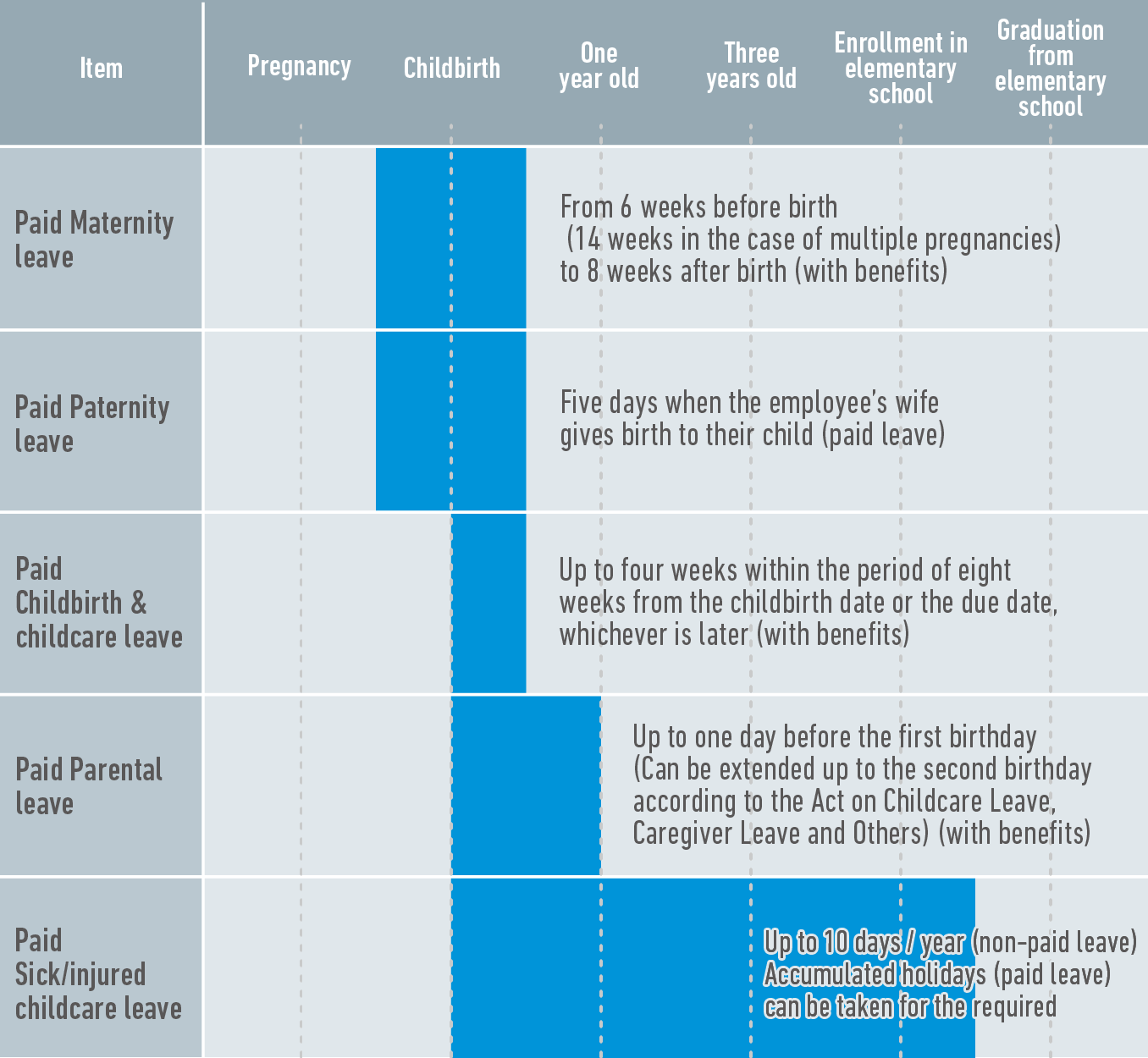
Workstyle for childbirth and childcare
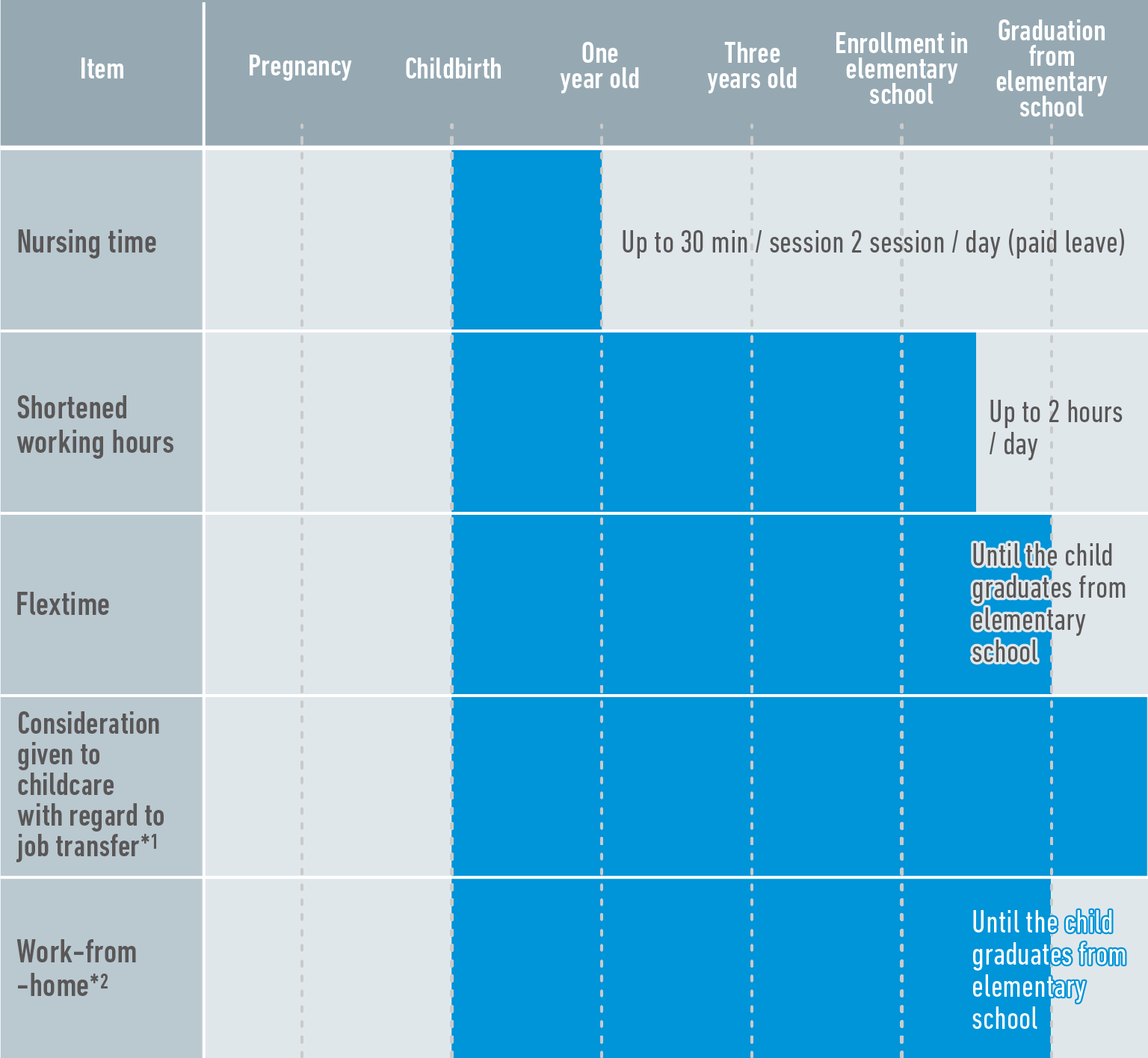
- *1 Consideration for relocation due to childcare: For transfer to a different location, enough consideration will be given to employees raising their children.
- *2 Work-from-home system: (Until the child graduates from elementary school) Can work at the house of the spouse’s parents/Can work intermittently between 5:00 a.m. to 10:00 p.m.
Support for childbirth and childcare
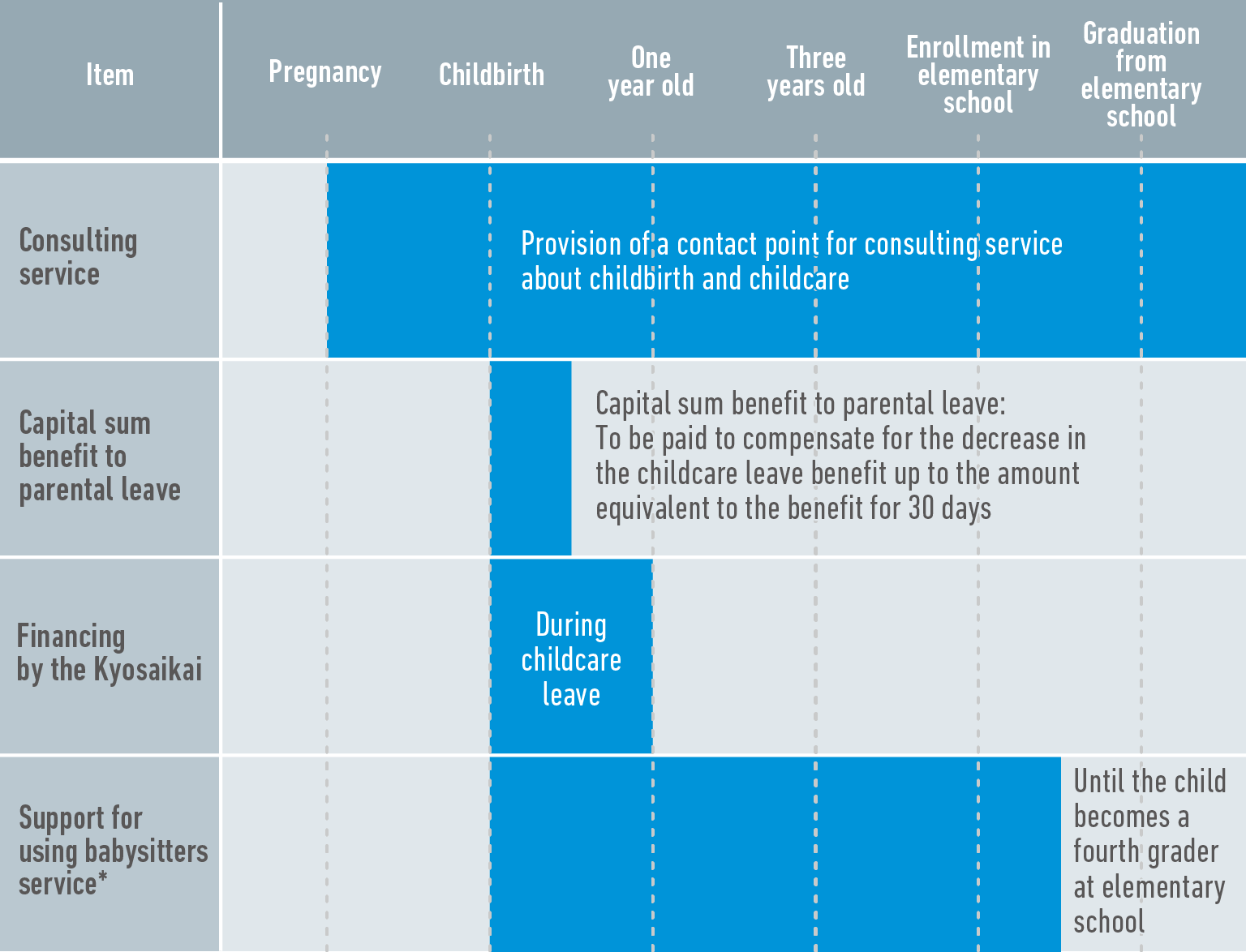
- *Support for using babysitters service: One discount coupon for babysitting service will be given to each eligible household per day.
- *Leave system for employees whose spouses are transferred overseas: Can be taken for up to three years
Support for nursing care
Leave and days off for nursing care
- Nursing care leave: Up to a total of two years per family member who is in need of long-term care. However, if the number of days taken off by an employee under the system does not exceed 93 days during the two-year period, the employee can take the leave also after the end of the period.
- Days off for nursing care: Can be taken for nursing care up to 10 days per fiscal year (Under the accumulated leave system, eligible employees can take days off as required.)
Work style related to nursing care
- Short working hours: Working hours can be reduced by up to two hours per day.
- Flextime
- Consideration given to nursing care with regard to job transfer: For transfer to a different location, enough consideration will be given to employees who have family members in need of nursing care
Support for nursing care
- Financing by the Kyosaikai employee cooperative society
Other Support
- 1.Integrated benefits program
- 2.Nabtesco corresponding education program
- 3.Qualification support program
- 4.English/Chinese lessons at each site
- 5.Support for club activities
Stability of Workforce
Nabtesco promotes labor management and related measures based on employee turnover data that details the reasons for leaving the company.
The graph on the right shows the rates of male and female employees that retired or resigned from Nabtesco. The rate of employees who resigned for personal reasons has remained at the 1% level, which shows that Nabtesco provides its employees with a good work environment.
We have no plans to implement wholesale layoffs or the encouragement of early retirement in FY2023.
Rate of those who resigned for personal reasons
- * The calculation scope covers only Nabtesco Corporation. The figures are based on the human resources data.
-
*
In FY2020, we revised the definition of “resignation for personal reasons.”
- : According to the revised definition, “resignation for personal reasons” includes termination of employment due to the death of the person, as a disciplinary punishment imposed by the company and all other reasons excluding those originating from the company.
- : The graph above shows corrected data for FY2019 and before.
- * From FY2022, in addition to regular employees, executive officers, reemployed workers, temporary workers, and temporarily transferred employees are added to the aggregate. As a result, the total turnover rate has fluctuated significantly from the previous year. Note that the data for the previous fiscal years has not been corrected.
Breakdown of Employees who Resigned or Retired (FY2023) (Unit: persons)
| (1)Total number | Retirees among (1) | Those who resigned for reasons related to the company among (1) | Those who resigned for personal reasons among (1) | |
|---|---|---|---|---|
| Managers | 18 | 11 | 0 | 7 |
| General employees |
92 | 39 | 0 | 53 |
| Total | 110 | 50 | 0 | 60 |
- *The number of voluntary resignations of executive officers and those who had been re-employed are excluded. The calculation scope covers only Nabtesco Corporation. The figures are based on the human resources data.
Breakdown of Regular Employees (as of December 31, 2023) (Unit: persons)
| (1) Number of permanent employee |
Number of managers among (1) |
(2) Number of newly hired employee |
Number of new graduates among (2) |
|
|---|---|---|---|---|
| Male | 2,199 | 327 | 116 | 68 |
| Female | 249 | 10 | 26 | 13 |
| Total | 2,448 | 337 | 142 | 81 |
- *The calculation scope covers only Nabtesco Corporation. The figures are based on the human resources data.
Average Age, Average Length of Service, and Average Annual Salary (as of December 31, 2023)
| Average age (age) | Average length of service (years) | Average annual income (thousands of yen) |
|---|---|---|
| 43.0 | 17.1 | 7,321 |
- *The calculation scope covers only Nabtesco Corporation. The figures are based on the human resources data.
